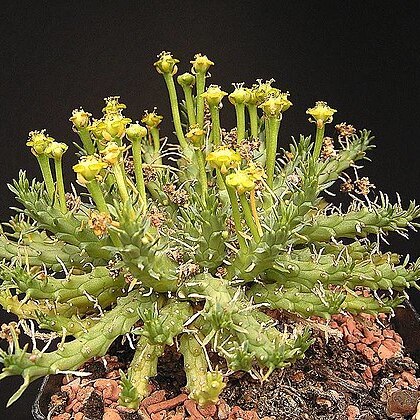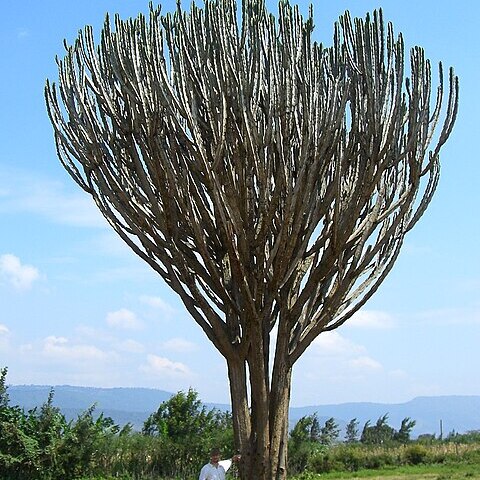Trees, shrubs, or herbs, rarely woody or herbaceous lianas, monoecious or dioecious, indumentum of simple, branched, stellate, or gland-tipped hairs, peltate or glandular scales or stinging hairs, latex often present, clear, white, or colored; roots woody, rarely roots tuberous and stems succulent, sometimes spiny. Leaves alternate or opposite, rarely whorled; stipules usually present, often free, sometimes modified into spines or glands, deciduous or persistent; petioles long to short, sometimes with glands at apex or base; leaf blade simple, sometimes palmately lobed, rarely compound, or reduced to scales, margins entire or toothed, sometimes with distinct glands along margin and/or on surface, venation pinnate or palmate. Inflorescences axillary or terminal, flowers in cymes or fascicles, these often arranged along an elongated axis, branched or unbranched, forming a thyrse, in congested heads, or in a flowerlike cyathium with very reduced flowers enclosed within a ± cupular involucre; bracts sometimes petaloid. Flowers unisexual, within same inflorescence or in separate inflorescences, actinomorphic. Sepals (1-)3-6(-8), free or connate into calyx tube, valvate or imbricate, rarely absent (Euphorbia). Petals free, often reduced or absent. Disk present or absent. Male flowers with disk intrastaminal or extrastaminal, entire to dissected. Stamens one to very many, hypogynous; filaments free or connate; anthers 2(-4)-locular, mostly dehiscing longitudinally, rarely transversely or by pores, introrse or extrorse; rudimentary ovary sometimes present. Female flowers rarely with staminodes; ovary superior, (1-)2-5(-20)-locular; placentation axile; ovules 1 or 2 per locule, anatropous or hemitropous; styles free or connate, entire or lobed, or multifid, lobes erect, horizontal or curved; stigma capitate, linear, fimbriate, fan-shaped or pinnatilobate. Fruit typically a capsule elastically dehiscent into 2-valved cocci from a persistent columella, sometimes a berry or drupe. Seeds 1 or 2 per locule; seed coat thin to indurate, sometimes fleshy to form a sarcotesta; caruncle sometimes present; aril sometimes present; endosperm present or absent; embryo straight to curved or folded; cotyledons usually broader than radical. x = 6-14.Trees, shrubs, or herbs, usually without latex (present in Bischofia); indumentum of simple hairs (branched in Phyllanthus reticulatus), often absent. Leaves alternate, often distichous, sometimes scalelike on main stems; petiole usually short, usually without glands (present in Aporosa); leaf blade simple, margin entire or minutely serrulate (long petioles, 3(-5)-foliolate with toothed margins in Bischofia); venation pinnate, rarely obscurely 3-veined from base. Inflorescences mostly axillary, without visible axis (present in Antidesma, Aporosa, Baccaurea, Bischofia, Richeriella). Male flowers with 2-8 stamens, anthers longitudinally dehiscent (variable in Phyllanthus); female flowers with 2 ovules per locule. Seeds without caruncle, sometimes with fleshy aril or fleshy testa.Trees to shrubs. Leaf blade leathery, grayish when dry, base often asymmetrical. Ovules 1 per locule; stigmas dilated, peltate or reniform. Fruit a relatively large 1-seeded drupe, usually crowned by persistent flaplike stigmas. Seeds without caruncle.Plants with or without latex; indumentum of simple, stellate, scalelike, stinging, or glandular hairs, sometimes absent. Leaves alternate or opposite; leaf blade simple or compound, sometimes deeply divided, margin entire or variously toothed, often with sessile glands near junction with petiole and/or along margins; venation pinnate or palmate. Inflorescences basically thyrsoid, very variable, often with well-defined main axis and/or distinct cymes, rarely a sessile axillary fascicle. Ovules 1 per locule of ovary. Seed sometimes carunculate, sometimes arillate.
Herbs, shrubs, trees or vines, annual, biennial or perennial; monoecious or dioecious; with or without latex (milky or variously coloured). Indumentum absent or of simple to compound trichomes (stellate, lepidote scales), rarely glandular, medifixed or stinging. Stems herbaceous, woody or succulent, prostrate to erect or scandent. Leaves mostly alternate, more rarely opposite or verticillate; simple, lobate or compound, rarely aphyllous, petiolate or sessile; pinnate or palmate; chartaceous, coriaceous or succulent; margins entire, dentate or toothed; stipulate (often deciduous) or not, stipules free or connate, sometimes glandular. Inflorescences mainly dichasial, axillary, terminal, lateral or leaf-opposed, cymose, paniculate, racemose, paniculate, spicate; flowers often in cymose glomerules, solitary or clustered in leaf axils, sometimes grouped into cyathia (glanduliferous involucrate pseudanthia) in tribe Euphorbieae; bracts often glandular. Flowers unisexual, actinomorphic (pseudanthia often zygomorphic), sometimes greatly reduced, nectary disk present or not; calyx free or united; sepals(1–) 3–6 (–8), imbricate or valvate, often much reduced or absent, often different between sexes; corolla free or united; petals (1–) 3–6 (–8), imbricate or valvate, often much reduced or absent, often different between sexes, sometimes brightly coloured. Male flowers: stamens 1–many (–400); disc present or absent, intrastaminal or extrastaminal, entire to variously lobed; filaments free or variously united; anthers erect to inflexed in bud, usually 2- (rarely 4-) locular and dehiscing longitudinally, obliquely or laterally by slits, rarely apically by pores, introrse or extrorse; pollen tectate or semi-tectate, usually 3-colporate, sometimes spiny; sterile pistillodes sometimes present. Female flowers: disk present or absent, hypogynous, entire to variously lobed; gynoecium syncarpous, ovary superior, sessile to stipitate, usually (2-or) 3-locular (sometimes more); placentation axile and with 1 or 2 ovules per locule (epitropous, inserted beneath an obdurator, crassinucellate with 2 integuments, protruding nucellar beaks and obdurators); styles as many as carpels, free or connate, erect or spreading, simple or variously lobed (bifid to multifid, laciniate); staminodes usually absent. Fruit smooth to variously ornamented, mainly loculicidally or septifragally and septicidally dehiscent 3–(20) carpellate capsules (often explosively dehiscent) into 3 segments (cocci) and a persistent, central columella), more rarely indehiscent berries or drupes. Seeds 1 or 2 per locule, carunculate (fleshy outgrowth of the micropyle) or not; seed coat thin to indurate; sarcotesta sometimes present; endosperm present or absent; embryo straight to curved, or folded; radicle superior; cotyledons broad, usually flat. [Note, this description covers Euphorbiaceae sensu lato, see Taxonomic Notes-Editor, 27 April 2021.]
Herbs, subshrubs, shrubs, trees, or vines [lianas], annual, biennial, or perennial, deciduous or evergreen, monoecious or dioecious; latex present or absent. Leaves alternate, opposite, whorled, or fascicled on short shoots, simple (3-foliolate in Tragia laciniata) [palmately compound]; stipules present or absent; petiole present or absent; blade sometimes palmately lobed, margins entire, subentire, repand, crenate, serrate, or dentate; venation pinnate, palmate, or palmate at base and pinnate distally. Inflorescences unisexual or bisexual, axillary, terminal, or leaf-opposed [cauliflorous], racemes, panicles, spikes, thyrses, cymes, fascicles, or pseudanthia, or flowers solitary. Flowers unisexual; perianth hypogynous; hypanthium absent; sepals 0 or 2–12, distinct or connate basally to most of length; petals 0 or (3–)5(–6), distinct or connate; nectary present or absent; stamens 1–35(–1000), distinct or connate, free; anthers dehiscing by longitudinal slits; pistil 1, (1–)3–5(–20)-carpellate, ovary superior, (1–)3–5(–20)-locular, placentation axile; ovules 1 per locule, anatropous; styles 1–5(–9), distinct or connate, unbranched, 2-fid, or multifid; stigmas 1–32+. Fruits usually capsules, dehiscence septicidal, (usually schizocarpic with cocci separating from persistent columnella, coccus usually dehiscent loculicidally), sometimes schizocarps, drupes, or achenes [berries]. Seeds 1 per locule.
Ovary superior, sessile or rarely stipitate, 1–4(20)-locular but most commonly 3-locular; placentation axile, with the ovules solitary or paired and collateral in each locule and pendulous from its inner angle, anatropous or hemitropous, rarely orthotropous (Panda), crassinucellate, bi-integumental, hilum between the ventral raphe and the epimicropylar obturator, when present; funicle often thickened; styles (1)3(4)(20), free or connate, erect or spreading, entire, bifid, multifid or laciniate, the inner surface usually stigmatic throughout, smooth, granulate, papillose or fimbriate, often reddish-or purplish-tinged
Fruit smooth, wrinkled, warty, tubercled, horned or winged, rarely inflated, often schizocarpic, dehiscing septifragally and septicidally into 1–4(20) (but usually 3) bivalved cocci leaving a persistent angled or winged columella, the valves then dehiscing loculicidally, or else fruit loculicidally dehiscent into 3 separate valves, or breaking up irregularly, or else indehiscent, drupaceous or subdrupaceous, with a thin epicarp, with or without a fleshy mesocarp and with a 1–3(more)-locular paleaceous, crustaceous, ligneous or osseous endocarp
Disk in the male flowers of 5–6 (occasionally more) free extrastaminal and/or interstaminal glands, less often the disk annular or cupular and extrastaminal or lobed, lobulate and intrastaminal with the stamens enfolded by the lobes, or else the disk receptacular, domed and aperturate with the stamens arising through the apertures, or disk absent; in the female flowers hypogynous, annular, flat or cupular, entire or lobed, rarely of separate glands, usually persistent, or absent
Stamens (1)3–100(1000), the filaments free or variously connate, simple or rarely branched, anthers erect or inflexed in bud, 2–4-thecous with the thecae usually parallel and adnate to the connective throughout, sometimes free at the base, occasionally completely free and erect, divaricate, horizontal or pendulous, rarely with the thecae superposed or laterally fused to form an annulus, dehiscing by slits longitudinally, obliquely or laterally, less often by pores (not Africa)
Leaves usually alternate, sometimes opposite, rarely whorled, occasionally all three, green or scarious and squamiform, petiolate or sessile, stipulate or exstipulate, simple, lobed or compound, entire or variously toothed, peltate or not, palminerved or penninerved, often with a pair or several pairs of basal glands at or near the petiole insertion, and/or sometimes minutely pellucid-glandular-punctate beneath
Seeds 1–2 per locule, or by abortion 1 per fruit, carunculate or not, often myrmecochorous; sarcotesta sometimes present; sclerotesta thin, crustaceous to thick, osseous; endosperm copious, fleshy, or absent; embryo straight to curved or folded, extending for most of the length of the seed; radicle superior; cotyledons usually broader than the radicle, flat, rarely thick and fleshy or folded
Inflorescences terminal, or axillary, lateral or leaf-opposed, cymose or paniculate, or racemose or spicate, or with the flowers aggregated into glanduliferous involucrate pseudanthia (cyathia), which may themselves be aggregated into pseudopleiochasial hyperinflorescences, or into involucrate capitula, or else with the flowers fasciculate or solitary, ramiflorous or cauliflorous
Prostrate, erect or scandent, annual biennial or perennial, dioecious or monoecious herbs, shrubs or trees, succulent or not, spiny or unarmed, sometimes poisonous, sometimes with phylloclades, with or without a milky latex or coloured sap
Calyx in both sexes usually of 3–6 valvate, imbricate or open, equal or unequal lobes, or of free sepals, often dissimilar as between the two sexes, rarely the female calyx spathaceous, sometimes accrescent, or minute or absent
Stipules free or connate, sometimes spathaceous, membranaceous, capilliform, glandular or spiny, subpersistent, readily caducous or absent
Ovary mostly 3-celled; styles free or united at the base; ovules solitary or paired, pendulous from the inner angle of the cells
Stamens 1–1, 000, free or variously connate; anthers 2–4-celled, erect or inflexed in bud, opening lengthwise, rarely by pores
Corolla in one or both sexes of 3–6 free or rarely united subvalvate or imbricate petals, or petals minute or absent
Indumentum absent or of simple, branched or stellate hairs or peltate scales, the hairs sometimes urticating
Leaves alternate or rarely opposite, simple or digitately compound, sometimes reduced, mostly stipulate
Sepals imbricate or valvate, or in very specialized inflorescences much reduced or absent
Seeds often with a conspicuous caruncle; endosperm copious, fleshy; embryo straight
Pistillode (non-functional ovary) often present, variously shaped
Staminodes absent or occasionally present, usually subulate
Flowers unisexual, usually actinomorphic, small to minute
Trees, shrubs or herbs, occasionally with milky juice
Petals absent or rarely present and sometimes united
Rudimentary ovary often present in the male flowers
Flowers unisexual, mostly monoecious
Fruit a capsule or drupe


